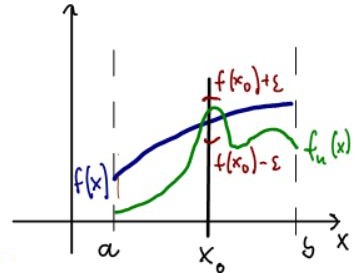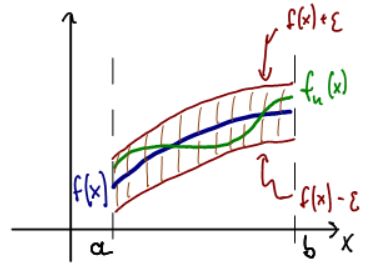If a Sequence Pn Converges Then Fpn Converges Prove F is Continuous
8. Sequences of Functions
8.2. Uniform Convergence
We saw in the previous section that pointwise convergence of a sequence of functions was easy to define, but was too simplistic of a concept. We would prefer a type of convergence that preserves at least some of the shared properties of a function sequence. Such a concept is uniform convergence.
We should compare uniform with pointwise convergence:
Let's illustrate the difference between pointwise and uniform convergence graphically:
Pointwise Convergence Uniform Convergence For pointwise convergence we first fix a value x0 . Then we choose an arbitrary neighborhood around f(x0), which corresponds to a vertical interval centered at f(x0).

Finally we pick N so that fn(x0) intersects the vertical line x = x0 inside the interval (f(x0) -
, f(x0) +
)
For uniform convergence we draw an
-neighborhood around the entire limit function f, which results in an "
-strip" with f(x) in the middle.

Now we pick N so that fn(x) is completely inside that strip for all x in the domain.
Uniform convergence clearly implies pointwise convergence, but the converse is false as the above examples illustrate. Therefore uniform convergence is a more "difficult" concept. The good news is that uniform convergence preserves at least some properties of a sequence.
Before we continue, we will introduce a new concept that will somewhat simplify our discussion of uniform convergence, at least in terms of notation: we will use the supremum of a function to define a 'norm' of f.
Clearly, a function f is bounded if and only if || f || <  , which follows immediately from the various definitions. The connection between sup-norm and uniform convergence is also straight-forward.
, which follows immediately from the various definitions. The connection between sup-norm and uniform convergence is also straight-forward.
Using this proposition it is can be easy to show uniform convergence of a function sequence, especially if the sequence is bounded. Still, even with this idea of sup-norm uniform convergence can not improve its properties: it preserves continuity but has a hard time with differentiability.
So uniform continuity is good enough to preserve continuity, but does not preserve differentiability. Our next question will of course be: what is the impact on integration? We already know that pointwise convergence does not preserve Riemann-integrability, and even if it does we can not switch limits and integration. What about uniform convergence?
| Theorem 8.2.7: Uniform Convergence and Integration | |
Let fn(x) be a sequence of continuous functions defined on the interval [a, b] and assume that fn converges uniformly to a function f. Then f is Riemann-integrable and
| |
Note: Much more can be said about convergence and integration if we consider the Lebesgue integral instead of the Riemann integral. To focus on Lebesgue integration, for example, we would first define the concept of "convergence almost everywhere":
| Definition 8.2.8: Convergence Almost Everywhere | |
| A sequence fn defined on a set D converges (pointwise or uniformly) almost everywhere if there is a set S with Lebesque measure zero such that fn converges (pointwise or uniformly) on D \ S . We say that fn converges (pointwise or uniformly) to f a.e. | |
In other words, convergence a.e. means that a sequence converges everywhere except on a set with measure zero. Since the Lebesgue integral ignores sets of measure zero, convergence a.e. is ready-made for that type of integration.
| Example 8.2.9: Convergence Almost Everywhere | |
| Let rn be the (countable) set of rational numbers inside the interval [0, 1], ordered in some way, and define the functions
| |
There are many theorems relating convergence almost everywhere to the theory of Lebesgue integration. They are too involved to prove at our level but they would certainly be on the agenda in a graduate course on Real Analysis. For us we will be content stating, without proof, one of the major theorems: the Lebesgue bounded convergence theorem.
| Theorem 8.2.10: Lebesgue's Bounded Convergence Theorem | |
Let { fn } be a sequence of (Lebesgue) integrable functions that converges almost everywhere to a measurable function f. If |fn(x)|  g(x) almost everywhere and g is (Lebesgue) integrable, then f is also (Lebesgue) integrable and: g(x) almost everywhere and g is (Lebesgue) integrable, then f is also (Lebesgue) integrable and:
| |
It remains to clarify the connection between uniform convergence and differentiability. Simple - or pointwise - convergence is not enough to preserve differentiability, and neither is uniform convergence by itself. However, if we combine pointwise with uniform convergence we can indeed preserve differentiability and also switch the limit process with the process of differentiation.
| Theorem 8.2.11: Uniform Continuity and Differentiation | |
Let fn(x) be continuously differentiable functions defined on the interval [a, b]. If: Then f is differentiable and f'(x) =for all x  [a, b]. In other words, the limit process and the differentiation process can be switched in this case. [a, b]. In other words, the limit process and the differentiation process can be switched in this case. | |
One of the main applications of our theory of uniform convergence is going to be series of functions and in particular power series ... which we will cover next.
Source: https://mathcs.org/analysis/reals/funseq/uconv.html

 fn(x) dx =
fn(x) dx =  and
and 
 | fn - f | dm = 0
| fn - f | dm = 0
0 Response to "If a Sequence Pn Converges Then Fpn Converges Prove F is Continuous"
Post a Comment